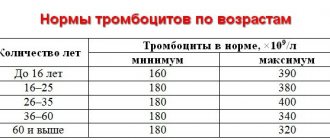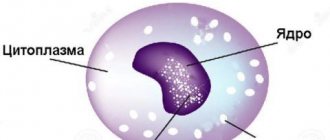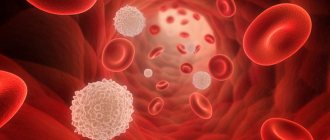1829
January 27, 2017
Causes of increased ESR in a child. When not to worry and when to pay attention. Elevated ESR syndrome. Treatment.
When visiting a hospital with a sick child or undergoing a mandatory medical examination, parents often receive a referral from a doctor (along with other tests) for a general blood test. This analysis reveals various indicators, including ESR (erythrocyte sedimentation rate) or ROE (erythrocyte sedimentation reaction). This indicator makes it clear at what speed erythrocytes (red blood cells) stick to each other.
Based on an increased ESR value and other signs of the disease, the doctor makes a diagnosis.
What is ESR and how is its value determined?
When you see numbers on a piece of paper in a child’s card that are marked by medical workers as indicators that do not correspond to standard values, you should not immediately panic. It is better to find the answer to the question why ESR is measured - erythrocyte sedimentation rate, and what a change in this indicator means.
By donating blood from a baby’s finger, parents can find out within an hour whether the ESR is elevated. The Panchenkov method, which is used to determine the ESR value in clinics and hospitals, allows you to quickly obtain results.
When donating capillary blood, it is important to ensure that blood is collected from the ring finger of a small patient without additional pressure from the medical staff. Blood that mixes with lymph when pressed and does not flow out on its own will give a distorted result: its biochemical and cellular composition will be changed.
Having mixed blood with an anticoagulant in a capillary - a special cone, an hour later they measure the column of plasma that remains after erythrocytes sink to the bottom. This distance is measured in a vertically located capillary and is the desired value: how many mm red blood cells descend in an hour.
If the red blood cells quickly reached the bottom, the ESR is increased; if they sank slowly, the ESR is decreased.
In boys and girls, in the period from 6 years to adolescence, the normative values of ESR will change repeatedly, so decoding should be carried out taking into account age-related changes for each child individually.
Normal indicators and interpretation for newborns and children of the first five years of life do not depend on gender, and from the age of 6, each gender and age will correspond to a range of values: the table of normative indicators will be an important help for parents when deciding whether further examination of the child is necessary.
| Child's age | ESR norm |
| Newborns | from 0 to 2.7 mm/h. |
| Up to 1 year | from 3 to 10 mm/h. |
| From 1 year to 5 years | from 5 to 11 mm/h. |
| Girls from 6 to 14 years old | from 5 to 13 mm/h. |
| Boys from 6 to 14 years old | from 4 to 12 mm/h. |
| Girls 14 years and older | from 2 to 15 mm/h. |
| Boys 14 years and older | from 1 to 10 mm/h. |
ESR studies in the described manner, which are carried out in all clinics, can be confirmed by donating additional blood from a vein and determining the erythrocyte sedimentation rate using the Westergren method. Abroad, this test is considered more reliable in determining ESR, since it is highly specific and takes into account all the nuances of changes that occur in the blood during the reaction. There is no need to prepare your child specially for the test; the only requirement is that there should be no breakfast before blood sampling.
The results of the clinical analysis determine which diagnostic methods the doctor will use in the future. The rate of increase in indicators helps to decide whether further research is needed and what it should be.
Reasons for false research results
Red blood cells, platelets, white blood cells and other blood components are in a certain balance in the body. If these indicators deviate from the norm, doctors may suspect the presence of a particular pathology. Sometimes it happens that the analysis has deviations, but this is not associated with certain diseases.
Let's look at what this might be connected with:
- During the cold season, a child often suffers from a lack of certain nutrients. This may affect blood and urine laboratory results.
- Another reason for the deviation is helminthic infestations in the baby. Parasitic infections most often affect young children, from 3 to 6 years old.
- Unbalanced diet. Eating too much fatty, salty, sweet, and smoked foods can negatively affect the results of a blood test.
- Taking antibiotics, Paracetamol and other medications can distort the results. Before conducting the study, be sure to inform your pediatrician if your baby has previously taken any medications.
- ESR norms by age may change due to the period of teething. An increased erythrocyte sedimentation rate is often observed during the eruption of eye teeth.
- Stress in a young patient can distort the data obtained during the analysis, for example, if the baby is very worried and afraid.
You may be interested in: If parents have blood types 2 and 3, what will their children have?
In infants, this indicator is directly related to the mother’s dietary habits. If abnormalities in the analysis are detected in the newborn, the woman needs to adjust her diet, exclude fatty foods and re-take the test after some time.
Physiological causes of elevated ESR
Blood is taken from a finger or a vein from the child in the morning. If you do this during the day upon admission to the hospital or for other reasons, you can get completely different data: at this time of day, an increase in ESR is often observed.
There are other physiological reasons that can cause increased ESR in the blood even in a healthy child.
It is necessary to take into account nutritional aspects when breastfeeding: infants are dependent on the mother’s nutrition. If her food is too fatty or not rich in vitamins, the baby will have a spike in ESR.
If the nutrition of mother and child can be regulated responsibly, no one will be able to avoid teething. During this period, not only the child’s behavior and other external manifestations of his internal well-being change: the ESR will also change upward. The reasons for increased ESR in the blood in children are both physiological and pathological.
The physiological characteristics of the child’s body tend to influence the increase in ESR, but often the reason for the increase in ESR in the blood is the child’s illness.
What are leukocytes
Leukocytes are called white blood cells. They help the human body fight pathogens. The level of leukocytes changes throughout the day, both up and down. Minor changes are usually associated with natural physiological processes and do not signal a disease. For example: a slight increase in white blood cells in a child’s blood appears as a reaction to new food or strong crying. The level of leukocytes is affected by stress, weather conditions, overheating, and physical activity.
A strong deviation from the norm, up or down, can be caused by diseases or disorders. White blood cell levels change as the child grows.
leukocyte cell
If for children under one year of age the norm is from 9.2 to 18.8 *109/l, then from one to three years it is already from 6 to 17,109*/l. At the age of up to 10 years, the normal level is considered to be from 6.1 to 11.4*109/l. From 10 years and older, leukocytes are normal at 4-8.8*109/l.
What diseases cause increased ESR?
A high ESR in a child is one of the diagnostically significant markers of health problems. Problems such as bleeding and autoimmune processes lead to it. Many cases of increased ESR are associated with inflammation and pathologies: with pathologies of the liver and kidneys in childhood, a change in the level of ESR in the blood is often observed. 23% of changes are associated with the occurrence of neoplasms, and not always benign.
Increased ESR during infections
When a child is poisoned by something or eats a low-quality product, he begins to vomit and have diarrhea: the ESR automatically increases. Intoxication of the body also occurs during viral and bacterial infections and leads to changes in the blood. Some infections (herpes, pneumonia) do not always manifest themselves in clear symptoms: an infectious focus helps to identify an increased ESR.
If monocytes have grown, ESR is increased by more than 30 mm/h, but the process is asymptomatic, other studies need to show that the child is sick and needs treatment, parents do not always recognize this: diagnosis may require new laboratory tests.
If an increase in ESR is the only symptom and blood was donated only for prophylaxis, you should still look for the reasons for the ESR deviation from the norm, so as not to miss a hidden infection and begin its treatment in time.
Increased ESR in inflammatory diseases
Inflammatory diseases are also the cause of increased ESR in children. Inflammation begins to develop after pathogenic microbes, as well as bacteria and viruses, enter the child’s body. Regardless of whether a child has an infection or not, the ratio of proteins in his blood changes during inflammation. This manifests itself in an increase in ESR. Severe inflammation can cause the ESR to jump several times, while mild forms give red blood cells a slight acceleration.
Deviation of ESR from the norm
Standard indicators of ESR are not only shifting upward. The result of clinical analysis is also a low erythrocyte sedimentation rate. A child who, for some reason, does not eat enough, eats only vegetarian food, will have a low ESR. Failure of water-salt metabolism also leads to such consequences.
In addition to physiological and pathological reasons, deviation of ESR from the norm can be associated with psychological reasons. A visit to the clinic does not cause joy for most children, but it provokes strong feelings. A baby who cried when blood was taken from his finger or vein will have an elevated ESR.
Methods for determining results
There are 3 methods for manually calculating ESR:
- According to Westergren. For the study, blood is taken from a vein and mixed in a certain proportion with sodium citrate. The measurement is carried out according to the tripod distance: from the upper boundary of the liquid to the boundary of the red blood cells that have settled in 1 hour;
- According to Wintrobe (Winthrop). The blood is mixed with an anticoagulant and placed in a tube with markings on it. At a high sedimentation rate of red blood cells (more than 60 mm/h), the internal cavity of the tube quickly becomes clogged, which can distort the results;
- According to Panchenkov. For the study, blood from the capillaries is required (taken from a finger), 4 parts of it are combined with a part of sodium citrate and placed in a capillary graduated by 100 divisions.
It should be noted that analyzes carried out using different methods cannot be compared with each other. In the case of an increased indicator, the first method of calculation is the most informative and accurate.
Currently, laboratories are equipped with special devices for automated calculation of ESR. Why has automatic counting become widespread? This option is the most effective because it eliminates the human factor.
When making a diagnosis, it is necessary to evaluate the blood test as a whole; in particular, leukocytes are given great importance. With normal leukocytes, an increase in ROE may indicate residual effects after a previous illness; if low - on the viral nature of the pathology; and if it is elevated, it is bacterial.
If a person doubts the correctness of the blood tests performed, he can always double-check the results in a paid clinic. Currently, there is a technique that determines the level of C-reactive protein; it eliminates the influence of external factors and indicates the human body’s response to the disease. Why hasn't it become widespread? The study is a very costly undertaking; it is impossible for the country’s budget to implement it in all public medical institutions, but in European countries they have almost completely replaced the measurement of ESR with the determination of PSA.
The indicator of high ESR with normal leukocytes provokes a number of questions. Many people are concerned about such conditions, because when leukocytes are elevated, we are talking about some kind of disease or pathology developing in the body. At the same time, an increased ESR signals the start of inflammation, which leads to the need for additional tests, so it is important to know what triggered the increase in one component and the preservation of the norm of another.
When an elevated ESR is the only symptom
Based on the fact that the child’s ESR deviated from the norm, no one recognizes him as sick. A lot of time can pass between the wording “bad tests” and a specific diagnosis. During this time, parents will have to carry containers with feces and jars of urine to the clinic, and take the child for an ultrasound or x-ray.
Regardless of the results of the analysis, treatment is prescribed to the child only when the disease is diagnosed and all the factors that influenced the change in ESR are determined.
When the ESR has skyrocketed for unknown reasons, additional opportunities for diagnosing the disease can be provided by a hormonal study, as well as an extended blood test - biochemical, sugar and C-reactive protein.
Only after carrying out the necessary studies, when the clinical picture becomes clear, will the doctor answer the question of whether the increased ESR is associated with the child’s illness: after all, the ESR also increases when his physiological state changes.
Why does ESR decrease?
The reason for the reduced value of this indicator may be a number of conditions:
- increased blood clotting;
- Congenital heart defect;
- liver abnormalities;
- anisocytosis or spherocytosis;
- severe dehydration of the body;
- hyperbilirubinemia;
- acidosis (blood acidification);
- poisoning.
A decrease in erythrocyte sedimentation rate occurs much less frequently than an increase in this value. To exclude errors in laboratory tests, it is better to re-donate blood for analysis.
How to bring ESR levels back to normal
Increased erythrocyte sedimentation rate is not a disease for which treatment can be offered. The level of ESR in the blood, which has jumped due to infection or inflammation, will return to normal only after drug treatment that stops this process. The doctor prescribes antibiotics and antiviral drugs in order to stop the disease: when the treatment is effective, control monitoring of the blood shows normalization of the ESR.
When a child’s analysis shows insignificant deviations from the norm, it is possible, with the consent of the doctor, to use traditional medicine methods to increase ESR.
You can reduce the ESR to standard values by regularly giving your child beetroot dishes. Folk recipes also include natural honey and citrus fruits: this combination will also improve ESR. You can add nuts to porridge, especially almonds and peanuts, raisins and bran, and include other foods high in fiber in the menu, as well as foods of animal origin. Between meals, it is useful to drink herbal infusions; you can give pureed garlic with lemon juice.
Vitamin complexes also help normalize the functioning of a child’s body: what vitamins to take and in what quantities should be determined by the doctor.
Increase in ESR. Medicines and folk remedies
The reasons for a low ESR were discussed above; to increase the indicator, medication is necessary (if it is heart disease, liver disease or diabetes).
During the treatment period, it is necessary to increase the number of meat and fish dishes and iron-containing products in the menu.
Additionally, you need to increase your fluid intake. In folk medicine, it is recommended to use: rosehip decoction, chamomile, raspberry juice. In combination you need to take vitamin preparations. Spend more time with your child outdoors.











